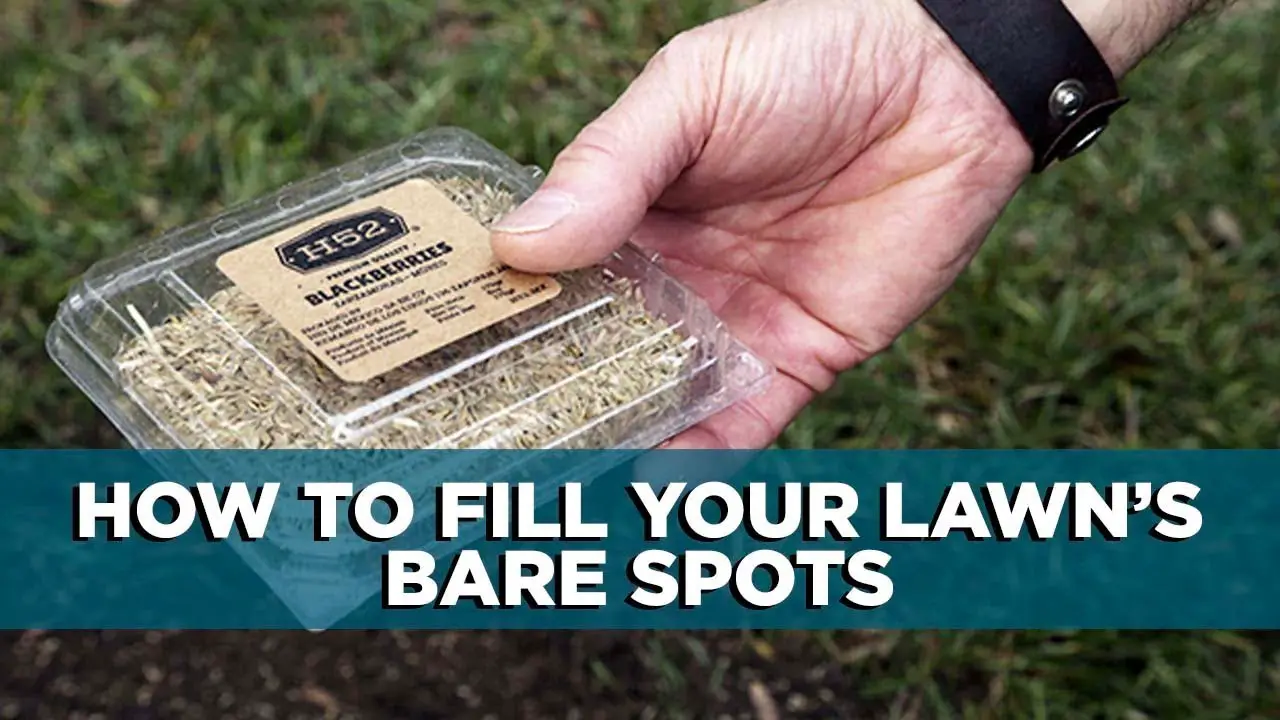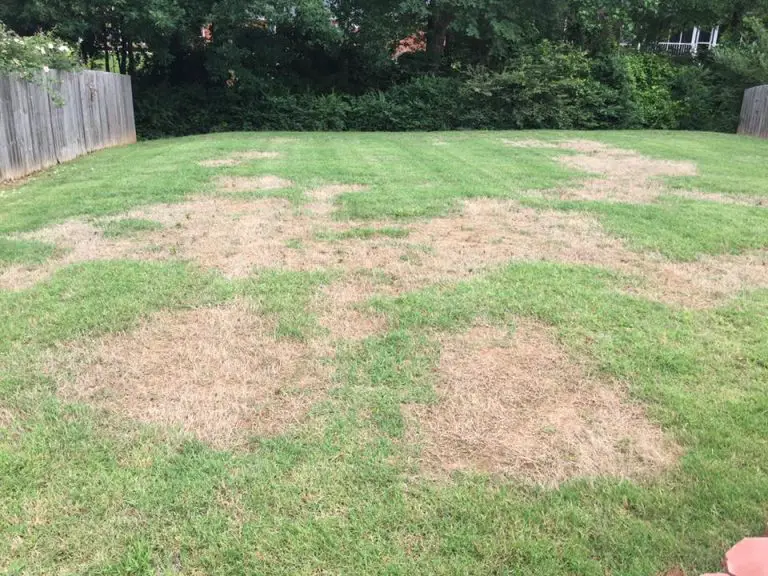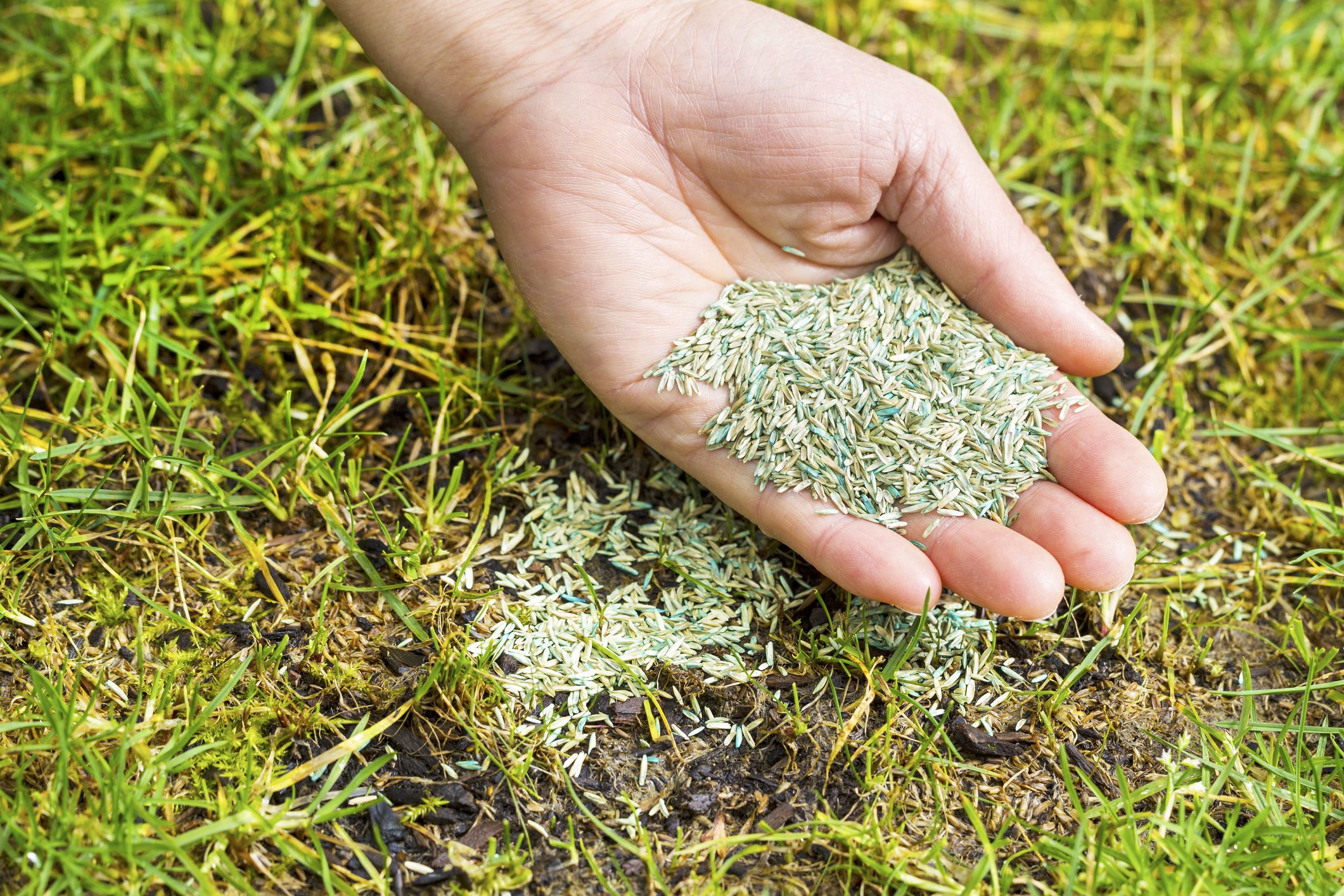Water New Seed Or Sod
Keep the area moist, not soaking wet. In some cases, you may need to water two or three times a day. And be patient! Depending on the type of grass, it can take a few days to a few weeks for it to germinate. Let the grass grow about four or five inches before its first mowing, so the seedlings dont get yanked out. And dont mow while the sprawl is wet to avoid creating tire ruts. Follow the same irrigation rules for sod, but dont mow it until you can gently pull on the pieces and feel that it has rooted.
What Causes Brown Spots In The Lawn
Discover the most common causes of brown patches in your yard and how to treat them.
It can be alarming and frustrating to see brown spots ruining what would otherwise be a beautiful green stretch of grass, especially if youre not sure how they got there or what to do about them. Brown spots in the lawn can show up for many different reasons, so the first step toward treating them is to identify the cause of the problem. Below are the most common causes of brown spots in the lawn and how to treat them so you can get your lush green lawn back.
Fungus
Brown spots due to fungal problems usually show up as irregular patches. If the disease has been active for a while, the inside of the patch may recover, leaving a ring of dead grass around it. Extremely rainy or humid weather can encourage fungal outbreaks, as can lack of sunlight and poor air circulation. Although you cant control the weather, there is something you can do to protect against fungus. ApplyScotts® DiseaseExLawn Fungicide according to the label directions to not only treat active diseases, but also to prevent future problems from listed fungi.
Grubs
Dog Urine Burns
Weed Dieback
Dead spots can also occur in the lawn when annual weeds like crabgrass, annual bluegrass, and foxtail begin to die back. This is a natural cycle that can be avoided with proper lawn maintenance and quickly patched withScotts® EZ Seed® Patch & Repair. As always, be sure to follow the directions on the label.
Thatch
How Does Grass Spread
So grasses spread in two methods. Either with the help of rhizomes or with the help of stolons.The rhizomes grow from the bottom of the grass and spread under the soil and grow in the lawn.
The stolons on the other hand branch out from the grass and run above the soil and spread the grass in the lawn. These two are the only way grass spreads in the lawn and if the grass doesnt have rhizomes or stolons then itll be very difficult for that grass to spread in the lawn.
You May Like: Who Makes Weedeater Lawn Mowers
Water The Grass Deeply But Infrequently
Water centipede grass to 1 inch of water in the dry months of winter to prevent winter desiccation and thinning. In the hot months of summer, water the lawn to protect the grass from drought stress. Apply less than 1 inch of water once per week in summer and reapply if centipede grass blades begin to dry and appear bluish.
Even when the grass is dormant, continue irrigating to prevent dehydration. Be sure to water deeply but infrequently to grow thicker centipedegrass. However, dont overwater the lawn as it can lead to weak roots, which are more susceptible to diseases and encourage weeds to grow.
Watering centipede grass will ensure it gets the correct amount of water at the time of need and will grow healthier and thicker.
How To Repair Bare Spots

The cause, of course, determines the cure.
If the bare spots are dog spots, Churchill suggests flushing the area with water to move excess salt through the soil. Afterward, prepare the soil for repair by scratching it up, even adding in some new soil to make the area level with the rest of the lawn.
If the cause of the bare spot is disease or other growth issues, Churchill says to scruff up the straw or dust from the dead area, add new soil and mix into the existing soil. Then overseed the area and water in as you would with new grass seed. If the area is bigger, you may want to consider sprigging or sodding to fill the bare spots. Generally, reseeding the spots will do.
Once you repaired the bare spots, Churchill says you shouldnt need to change maintenance practices, other than spot-irrigating the areas that were reseeded, sprigged or sodded.
Also Check: Cost Of Trugreen Annual Plan
Dont Just Automatically Water More
When you see dead spots, your natural inclination might be the same of many homeownersto just start watering more. But as weve discussed, brown and dead spots do not always mean drought and excess water can actually exacerbate certain problems.
For instance, watering incorrectly can cause a fungal disease to spread. Plus, if overwatering is actually the root cause of your problems, more water is only going to make the problem worse.
Quick Guide To Lawn Repair
1. Patch your lawn. Repair thin or bare spots with Scotts® EZ Seed® Patch & Repair or Scotts® Sprouts. Both are great solutions, but take two different approaches . There is one exception: If you have a St. Augustine lawn, its best to pull up dead turf or edge out bare spots. Apply Scotts® EZ Patch Lawn Repair for St. Augustine Lawns then place new sod or plugs.
2. Water well. New seed and sod require more frequent watering. Keep your soil moist, but dont drown it.
3. Feed your lawn. After 6 to 8 weeks, give your new grass the nutrients it needs to grow lush and strong. Feed your entire lawn with Scotts® Turf Builder® Lawn Food.
4. Kill weeds and pests. Bugs and weeds will try to creep into your lawn while it grows. Before you apply any weed or bug control product, check the product label to see when it can be applied to new grass.
5. Mow later. Be sure to wait until your lawn is at mowing height before you mow.
Don’t Miss: Is Bioadvanced Fungus Control Safe For Pets
How To Patch A Lawn With Seed
Mow the existing grass in the area down as low as you can. Youll want your seeds to have direct contact with the bare, exposed soil. Dig a border using a sharp spade and get rid of any debris or weeds in the delineated area. Rake up the soil, then leave it level and smooth.
Distribute the seed with a spreader, using the appropriate amount for the designated space. Spread the seed so that it covers the surface, but dont let seeds overlap with one another. For uniformity, spread half the seed in an east/west pattern and half the seed north/south.
Rake over the seed for even distribution. Then, cover the top with a thin layer, about ½ an inch, of straw or topsoil to keep the seeds moist and protect them from birds.
For the first week or two, youll need to water your lawn daily or twice a day to make sure the soil is moist, but not soggy. Once the seedings begin to emerge, you can dial back the irrigation to two deep, infrequent waterings totaling 1-1.5 inches per week.
Do not mow until the grass reaches a height of about 3-3.5 inches. Then, be sure to cut no more than the top of the grass blade to encourage drought resistance and deep root growth, and discourage weeds.
It may take up to eight weeks, depending on the grass type you selected, for the new grass to blend in fully with the rest of your lawn. If you need to mow the rest of your lawn before then, be careful to avoid the newly seeded grass.
How To Patch Holes In Your Lawn
Heres how to fix those ugly bare patches in your yard.
No matter how much TLC you give your lawn, its inevitable that unsightly patches and holes will show up on your beautifully manicured yard. But you dont have to put up with those scraggly areas.
Heres how to say so long! to those holes in your lawn:
You May Like: How To Fix A Yard Full Of Weeds
Water Generously At First Less Later
Water the area immediately, and then continue to water lightly three times a day for 7-10 days. When you can see the new grass sprouting, reduce watering to once daily.
Tip: After the new grass emerges, less is more. A good, thorough soaking rather than a quick watering ensures that the water gets down to the root system. This helps roots grow strong and deep for a thick, more drought-resistant lawn.
How To Fix Dead Spots On Your Lawn
Your lawn is the first impression of your home. A luscious, green plot rich with life gives off a calm energy and inviting atmosphere to all your guests and neighbors.
Bald, dead spots in your grass detract from your homes overall presentation and can interfere with the beautiful lawn every homeowner wants.
Dead spots can appear even when you follow a regimented watering and fertilizing routine. Sometimes, brown grass and dead spots are indicative of a harmless problem that can be easily remedied, like pet urine or your lawn not getting enough water.
But other times, they can be indicate a larger problem like pest infestations beneath the dirt.
The first step in treating these spots is figuring out what caused them. From pests to pets to not enough water, well help you figure out what may be causing dead spots in your lawn, how to treat them, and how to prevent them so that you can have a beautiful, inviting lawn all season long.
Dont Miss: How To Get Rid Of Ant Hills In The Lawn
Don’t Miss: Humichar Home Depot
How To Make Centipede Grass Thicker And Fuller
A centipede lawn has the lowest maintenance needs compared to other warm-season grasses. It is often called the lazy mans lawn because it requires less fertilizer and infrequent mowing. However, the turf will easily grow thin with weeds and diseases taking over if you dont give it proper care. So, how do you make centipede grass thicker and fuller?
Apply 1-2 pounds of nitrogen fertilizer per 1000 sq. ft. of lawn during the active growing months to make centipede grass grow thicker and fuller. Also, provide 1 inch of water every week and mow the lawn at 1-1.5 inches high to maintain its vigor. Overseed the lawn if there are any thin areas.
A Lush Lawn Can Still Be Prone To Bare Spots We Take A Look At The Causes How To Repair Them And Cover The Bare Spots

You finally have your lawn just how you want it green and lush and thriving. Then, all of a sudden, a bare spot appears. What to do? To find out why bare spots occur, and how to fix them to return your lawn to its splendor, we checked in with Joe Churchill, senior turf specialist with Reinders, Inc. to share his insights and tips.
Recommended Reading: Wild Violet Herbicide Control
Sunday Patch Kits Make It Even Easier
The Patch Pro grass seed blend is optimized to work in most lawn conditions, and to grow in quickly. Our organic mulch helps to retain needed moisture and provide nutrients to the new grass.
Sunday Patch Kits are available to add on to your lawn plan at check out or from your plan account page at anytime.
Water The New Grass Plugs
- Your watering schedule will probably look something like this:
- Weeks 1 2: 3 times a day for 20 minutes
- Week 3: 2 times a day for 20 minutes
- Week 4: Once daily.
- Thereafter: Follow the normal watering recommendations for the grass you are plugging.
- They can be a bit tricky to learn at first, but once you get the hang of it they are invaluable time savers.
- These sprinkler can be adjusted down to water even very small areas.
Don’t Miss: Keep Geese Off Your Lawn
How To Patch Bare Spots With Sod
For a quicker fix than reseeding, try using sod. Sod is a fairly inexpensive way to repair bare spots of dead grass.
- Remove Debris
Similar to reseeding, remove any leaves, dead grass, weeds, or debris from the brown patch area before getting started.
- Till the Soil
Using a garden hoe or rake, till the soil a few inches deep to break up the solid pieces of dirt.
- Measure the Area of the Brown Patch
Use a tape measure to evaluate the width and length of your brown patch. Then, purchase a piece of sod from your local gardening store that will fully cover the area.
- Select the Right Turfgrass
Be sure to select the correct turfgrass sod for your lawn, identify the grass you have growing, and try to match this when buying pieces of sod.
- Cut the Sod
Using a sharp shovel or garden tool, cut a piece of sod that is slightly larger than the area you are covering.
- Lightly Fertilize
Applying a small amount of fertilizer to the soil before laying sod will encourage the roots to establish and anchor down the sod piece.
- Firmly Place the Sod Piece
Place the sod on top of the brown patch matching the shape as best you can. Compress the sod down into the lawn by tamping it down with a rake and then immediately walking on it.
- Water the Sod Immediately
The sod will need more water than regular seed grass. Keep the area moist by watering two to three times a day if needed. Monitor the edges of the new sod they will dry out first.
- Hold Off on Weed Control
- Assume Regular Lawn Treatment
Break Up The Bare Spot And Reseed
Use a small gardening shovel or rake to break up the dry spot on your lawn. Remove any rocks, leaves or debris. Choose the appropriate grass seed for the spots shade density and cast the seeds over the turf. Spread about a half an inch of compost or topsoil on the strewn seeds.
Tip: To get good seed-to-soil contact, gently rake the seeds and soil into the grass.
Don’t Miss: How To Treat Ant Hills In Lawn
How To Repair A Bare Patch Of Lawn
wikiHow is a wiki, similar to Wikipedia, which means that many of our articles are co-written by multiple authors. To create this article, volunteer authors worked to edit and improve it over time. This article has been viewed 42,453 times.Learn more…
Bare patches can be a nuisance and usually let the garden down. But there are certain tricks that can be useful in these circumstances. From shade to compaction, there is a solution for most bare patches. This article provides some suggestions for repairing a bare patch of lawn.
Tips For Reseeding Bare Spots In Your Lawn This Spring
Posted byScott Stueber on May 28, 2019 10:10:41 AM
Are you disappointed with how your lawn looks this spring? Do you have bare spots? Harsh winters, insects, animals, and disease can wreak havoc on your lawn. While Im not striving for the perfect lawn, I do take pride in having a nice, healthy one.
If youre frustrated with how your lawn looks and you want to fix the bare spots, you can! For existing lawns, lawncare professionals recommend core aeration and over seeding in the fall. This process promotes overall healthy growth and can help thicken it. However, you can add seed to your lawn in the spring and experience good results.
Here are some tips for fixing your lawn.
1. Determine the best time to plant.Depending on where you live, certain times of the year will generate better results. In the Midwest, cool-season grass seeds will germinate when soil temperatures consistently range between 50 and 65 degrees Fahrenheit. If you live in southern states, warm-season grass seed will germinate when soil temperatures are between 70 and 80 degrees Fahrenheit.
If the soil temperatures are confusing, a less technical rule of thumb is grass seed germinates when the air temperature is consistently between 60 and 80 degrees Fahrenheit.
Lastly, if you experience a cool spring or summer, germination may take longer, or it may fail.
- Does your lawn get full or partial sun?
- Do you have pets?
- Does your lawn get light, moderate, or heavy foot traffic?
Don’t Miss: Lawn Rust Treatment Fungus
What To Do If Your Bare Spot Is Exposed Soil
Does Fescue Grass Spread

Fescue grass is a non-spreading species as it doesnt have rhizomes or stolons growing from the plant. Fescue grass is also known as bunchgrass because it grows in bunches and can become dense in one spot.
Fescue grass grows vertically with the help of tillers and leaf blades growing from the basal shoot of the mother plant. One fescue plant can produce many tillers and can grow dense but it cannot fill bare spots or spread out with new plants.
Recommended Reading: How To Thicken A Thin Lawn
